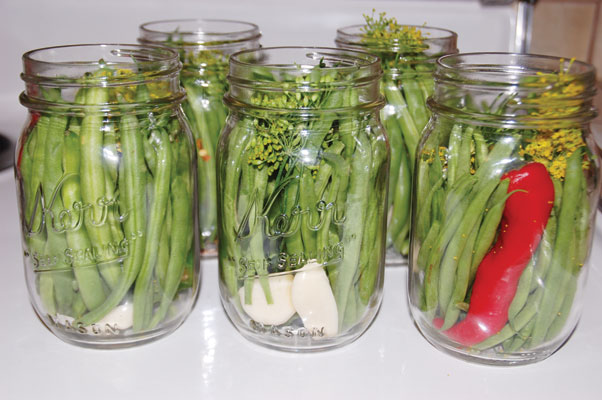Beans and beets, carrots and cucumbers are just a few of the
many produce harvesting in abundance over the next few months. What
better way to preserve some of that harvest for the winter months
than canning? Read the different methods below, take a class and
get started.
There are three methods to choose from when preserving foods:
steaming, water bath boiling and pressure canning.
Steam canning and water bath boiling are the best methods for
steaming acid foods such as fruits to make jams and jellies and
tomatoes, salsas and spaghetti sauce. These two methods are also
good for pickling vegetables and for those trying canning for the
first time.
You will need a large canning pot with lid and a jar rack to
steam and boil. Using a jar-lifting tool to remove hot jars is
essential and investing in a magnetic lid lifter is also a good
idea for getting lids out of the boiling water. If you are working
with fruits you will also need a strainer or food mill to remove
seeds.
Pressure canning will require different equipment. If you have
canned before and now want to try your hand at canning meats, fish,
and stews, then you will need a pressure canner.
“If you are canning certain vegetables, like corn, then you need
to use pressure canning otherwise the shelf life is not as long,”
said Sarah Spears, 75, who started canning with her mother when she
was ten-years-old.
Pressure canners have lock lids and cost about four times as
much as the pot for steaming and boiling. If you have never tried
canning before, start with one of the first two methods before
moving to pressure canning.
Start your canning project by taking a class from one of the
many offered around Sonoma County next month. Pro canners will
teach you tips like the importance of cleaning your jars before
putting the lids on, to ensure that they will seal properly.
“You always have to make sure your jars are clean and your rims
dry and clean and make sure to wipe the inside as well as the top
and the rim,” Spears said.
Using a paper towel, wipe around the top and inside of the jar.
This will also eliminate harmful pathogens, germs and bacteria from
growing in your jars.
When treating vegetables, make sure you understand how they need
to be handled and whether they have to be blanched, salt sweated
and if they require special boiling or steaming time.
“When you are making pickles they should be really fresh out of
the garden and sometimes I put them in ice water and let them sit,”
Spears said. “And also, Ball puts out a product called pickle crisp
for pickling that helps keep your vegetables crispy,” Spears
said.
Spears cans everything from dill pickles and relish to
strawberry and blackberry jams. Her most popular product is
tomatoes which she uses to make her award winning salsa.
“I use a teaspoon of salt and lemon juice for my tomatoes,”
Spears said. “When I take the skins off, I blanch the tomatoes but
you don’t want to over blanch them or your tomatoes will get
mushy.”
The other trick Spears says works best for making salsa is to
can the tomatoes and use those to make fresh salsa as you want
it.
“The salsa has a different taste if you can it rather than make
it from canned tomatoes,” she said.
One last thing Spears says canners must know, is that it is
important to follow your recipe so that your product tastes
good.
Spears recommends ‘Ball Blue Book’ for beginners for simple
recipes.
Canning Classes
Food Preservation with Wendy
Krupnick
September 8 @ 6:30 p.m.
Sebastopol Hardware
660 Gravenstein Hwy.
www.sebastopolhardware.com
Award winning canner Sarah
Spears
September 11 @ 10 a.m.
Tomato & Pepper Festival Windsor
Farmer’s Market
Windsor Town Green
www.windsorfarmersmarket.com
Yes We Can: Canning Three
Ways
September 18 @ 1 p.m.
Chef Elissa Rubin-Mahon
Relish Culinary Adventures
www.relishculinary.com
SPICY PICKLED
GREEN BEANS
Makes about six jars
Preparing the canner, jars and lids:
POT-Fill the canner with water until it covers the jars by at
least one inch. Cover the pot and bring to a boil, this will take
30 to 40 minutes.
JARS-Make sure your jars are clean and hot by running them under
hot tap water before filling with beans. The jars need to be warm
when they are put into the boiling pot to prevent breaking.
LIDS-Wash and rinse lids and screw bands and fill a small pan
with water. Add only the lids and bring the water to a simmer. Do
not boil or the seal will harder and be unusable.
3 pounds green beans
6 garlic cloves
6 pickling dill flowers (different
3 red chiles cut in half
1 ½ cups granulated sugar
3 tablespoons pickling salt
1 tablespoon celery seeds
1 tablespoon mustard seeds
4 cups white wine vinegar
2 ½ cups water
1 cup apple cider vinegar
1. Cut or snap steams of the green beans
2. In a large pot, combine sugar, salt, celery seeds, mustard
seeds, white vinegar and apple cider vinegar. Bring to a boil over
medium-high heat until sugar and salt are dissolved.
3. Fill jars with green beans, garlic cloves, dill flowers and
red chile.
4. Pour pickling liquid over the beans, leaving one inch of head
space from the top of the jar. Wipe rim clean around the top and
side edges and secure a lid and screw band tightly around each
jar.
5. Fill jar rack and lower into boiling water. Place lid on pot
and let boil for 20 minutes. Remove lid and turn off the heat after
20 minutes and let jars stand for five minutes before removing from
the water.
6. As the jars cool on the counter-top, you will here each one
pop and seal. Any that do not seal, cannot be saved.
Beans are ready to be eaten after one week and can last up to
one year. It is always best to mark the top of your lids using a
Sharpie to indicate the date.








